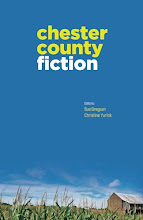Friday, September 28, 2012
Chester County Fiction Anthology, One Year Later
One year ago, local writer Jim Breslin put out an anthology called Chester County Fiction. I had two short stories in this collection.
There was doubt as to the viability of an anthology which would, presumably, be of local interest only. The contributors weren't paid, but Jim promised that, if he made his investment back, we'd have a party for the authors and donate some of the proceeds.
Well, the anthology did surprisingly well. And this past Wednesday night, at a reception at the historic General Warren Inne in Malvern, Pennsylvania, we donated books and an iPad to the IHM Family Literacy Program in Coatesville, Pennsylvania.
(No, I'm not going to identify everyone. But there are two Immaculate Heart of Mary nuns in this photo. Can you guess which ones they are?)
Sunday, September 2, 2012
Full Time Reporter, Part Time Extortionist
Harry Karafin isn't a name you hear much these days. He was before my time, too. Back in the late 1950s through the mid-1960s, though, he was the most feared investigative reporter in Philadelphia.
People had good reason to fear him. In addition to being a reporter, he was also an extortionist. He would "suggest" to businessmen - especially shady businessmen - that they should hire the public relations company Harry Karafin ran on the side. If they refused, then an exposé about their business would appear in his paper, The Philadelphia Inquirer. That was usually enough to force the victim to start paying Harry Karafin. If it wasn't, there would be follow-up stories, usually demanding an official investigation. His articles could - and did - result in hearings and arrests. Investigations from state officials from Harrisburg, not the Philly officials who could be bought off.
Harry Karafin never extorted organized crime figures. He was too smart for that. Harry knew - and interviewed - the Godfather of Philadelphia's mob, Angelo Bruno. Harry's prey were crooks who weren't connected: aluminum siding salesmen, real estate scam artists, shady home repair businesses, encyclopedia men. The guys who promised much, got people who couldn't afford it to take out loans, and delivered little if anything. They made their money from the loans - the paper - not from the businesses they were supposedly in.
I saw the name Harry Karafin in The Inquirer yesterday. It was mentioned in the obituary of another reporter, Gaeton Fonzi, who just passed away at the age of 76 down in Florida.
Gaeton Fonzi, along with his late writing partner Greg Walter, was the man who exposed Harry Karafin.
This exposé of Philadelphia's most feared reporter didn't appear in The Inquirer, of course. In those days, The Inquirer ran a distant second to The Philadelphia Evening Bulletin. (Like most evening newspapers, The Bulletin is long gone now.) The Inquirer had been gutted by a thirty-eight day strike in 1958. There were hardly any experienced reporters left after the strike. Former copy boys were promoted to reporters. Harry Karafin was one of the only experienced reporters left. In essence, he was The Inquirer's entire investigative journalism division, and management didn't look very carefully at how he got his stories. And Harry Karafin had the best connections in Philadelphia media, from city hall down to the mob guys. He could walk into the Philadelphia District Attorney's office and look through the files without restriction...which helped him pinpoint the shady businessmen that he could extort.
There were plenty of rumors about Harry Karafin. He was a braggart, and knew nothing about hiding his ill-gotten gains. On a reporter's salary of less than $11,000 a year, Harry somehow gave his wife expensive jewelry and furs. He bought twin Buicks - even though he was the only one in his house who knew how to drive. He paid a builder $30,000 to build him an expansive house in the far reaches of Northeast Philadelphia, putting down $19,000 cash. Then he and his wife filled the house with $20,000 worth of furniture.
Harry Karafin didn't hide any of this. He figured he was too big to take down. He even boasted that he was so connected that his daughter's engagement party at Palumbo's (one of the city's top clubs) didn't cost him a dime. The notorious Walter Annenberg was the publisher of The Inquirer in those days. Harry Karafin liked to introduce himself as "Walter Annenberg's hatchet man."
The exposé of Harry Karafin didn't appear in any of Philadelphia's newspapers. Gaeton Fonzi and Greg Walter worked for Philadelphia Magazine. The magazine published the exposé, in April of 1967, despite legal action by Karafin to suppress it. In fact, that article is considered the start of investigative journalism in regional magazines.
You have to wonder if a magazine would print such a story today, when faced with a lawsuit.
The exposé worked. The Inquirer was forced to fire Harry Karafin, and a year later he was convicted of extortion. You can read Fonzi and Walter's article here. They wrote longer back then: it's seventeen pages long. But it's well-written, with a nice button at the end.
Harry Karafin is still mentioned in journalism circles. I never went to journalism school, although I have written for several different papers. I first heard of Harry Karafin in fiction. Back in 1981, mystery novelist Richard Hoyt wrote a newspaper-based mystery called 30 for a Harry, about a newspaper extortionist. It was a good book, but it's long out of print now. If you run across it in a used bookstore, this is what it looks like:
It's an enjoyable read, although not Hoyt's best work. I'd pick Fonzi and Walter's exposé of the real Harry Karafin any day.
Subscribe to:
Posts (Atom)




